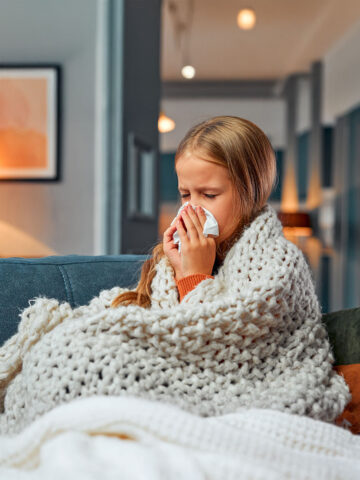While pets can bring so much joy to families, they also tend to bring dander, saliva and dust into the home that may be harmful to kids with asthma or allergies.
Both furry animals and feathered friends can be an allergen trigger for kids. Besides carrying dander (skin flakes that are kind of like animal dandruff), saliva (spit) or pee, animal fur or feathers also can collect other things that can make asthma symptoms worse like dust mites (tiny bugs), pollen (from plants) and mold.
And any animal that lives in a cage — from birds to gerbils — will have droppings that get mold and dust mites on them too.
Here, CHOC experts offer parents advice on how to determine if their child is struggling with pet allergies and what to do to help.
Common pet allergy symptoms
Pet allergy signs and symptoms will resemble what is typically seen with seasonal allergies caused by the inflammation of nasal passages, like:
- Sneezing.
- Runny nose.
- Itchy eyes and ears.
- Sore throat.
- Frequent upward rubbing of the nose.
If your child has asthma, pet allergies make worsen their asthma symptoms and they may experience:
- Difficulty breathing.
- Chest tightness or pain.
- Coughing.
How can I help my child deal with pet allergies?
If you think your child may be allergic to your pet, visit your pediatrician. You may need to have your child tested for allergies.
If your child has been diagnosed with an animal allergy, you’ll have to decide whether to keep your pet or find it a new home. The best course of action may be to remove the pet from your home, though this isn’t usually the easiest or happiest solution. Your child, other kids in the family and even adults may have a tough time with this decision.
In some cases, your doctor may say it’s OK to keep a pet if your child takes medicine or gets allergy shots, which are regular injections to stop or reduce allergy attacks.
For kids taking regular asthma medications, allergy medicine and shots can help control asthma attacks. But even with allergy medication or shots, you’ll still need to limit your child’s exposure to the animal.
Get CHOC’s ultimate guide to avoiding indoor allergy triggers.
Here are some tips to help limit your child’s exposure to allergens from your pet:
- Keep pets out of your child’s bedroom and playroom.
- Encourage your child not to hug or kiss the animal.
- Vacuum and dust regularly and avoid rugs and wall-to-wall carpeting, especially in your child’s bedroom.
- Have someone other than your child wash or brush your pet every week. Bathing your animal weekly may help reduce the amount of dander it spreads in the home.
- If you have a cat, keep your child away from the litter box, and place the box away from air vents.
- Encourage everyone in the family wash their hands after playing with your pet.
- If you have a pet that lives in a cage, keep it in a room that your child doesn’t spend time in regularly. Also, have someone other than your child clean the cage daily. Let teachers know about your child’s allergies if there’s a caged animal in the classroom.
- Consider buying an air cleaner with a HEPA (high efficiency particulate air) filter for your child’s bedroom or playroom. Central air filtration systems are also an option but are much more expensive.
Sometimes, such measures may not be enough. Because animal allergens are airborne, heating and ventilation systems will spread allergens throughout the house, even if the pet is kept out of bedrooms.
What if we can’t keep our pet?
If your child still has symptoms after taking medicines, including allergy shots, or needs a bunch of medicines to be around your pet, your only choice might be to find a new home for your pet.
If so, be sure to discuss this with your child. Reassure your child that this isn’t his or her “fault” — and make sure siblings don’t blame the child. Losing a pet, even to a friend’s home, can be hard for everyone in the family.
After a pet is removed from the home, it can take several months before dander is totally gone.
When visiting another household with a pet, your child should first take any prescribed allergy medicine and bring along their asthma inhaler, just in case.
For more health and wellness resources from the pediatric experts at CHOC, sign up for the Kids Health newsletter.
Find a CHOC Primary Care Pediatrician
From babies to teens, pediatricians from CHOC’s Primary Care Network partner with parents to offer immunizations, sick visits, sports physicals and more.





